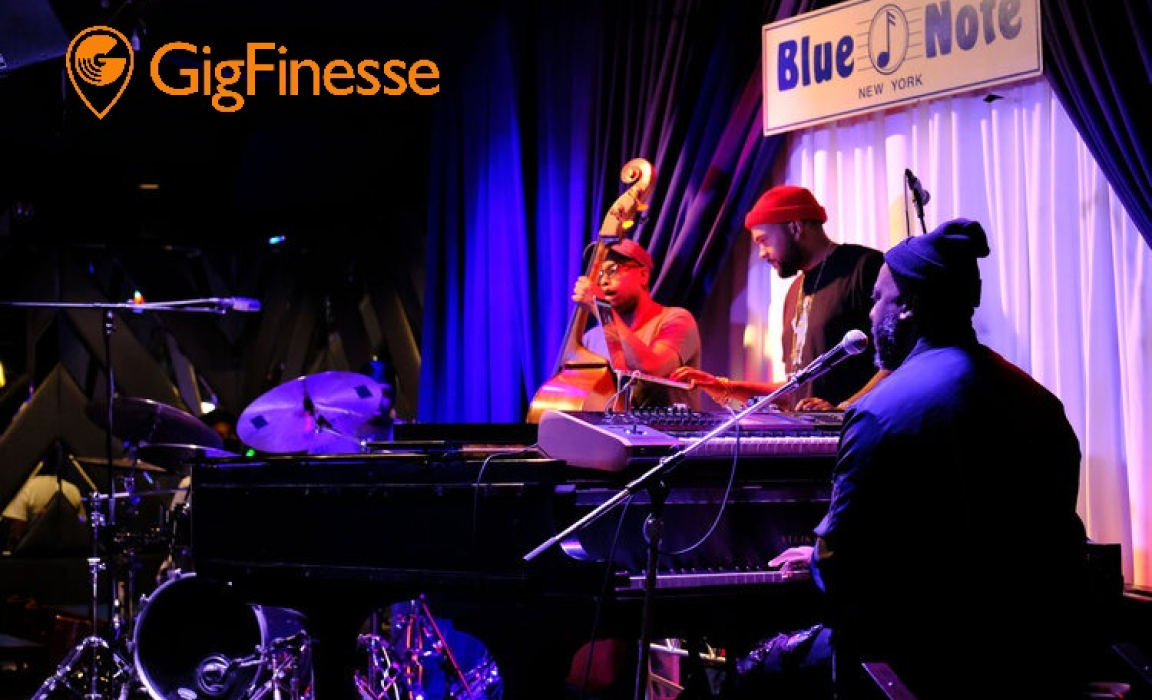I recently visited a WeWork workspace on Broadway, where founder Mir Hwang and his New York team nests. Hidden in a conference room on the tenth floor of 524 Broadway, Mir and his startup, GigFinesse, are stealthily disrupting the $31 billion Live Music Industry.
Mir is a recent graduate from NYU’s College of Arts and Sciences with degrees in Chemistry and Psychology, who’s also a seasoned drummer and came to NYU for the music scene. “Growing up in a traditional Asian-immigrant household, becoming a drummer is just not something in the cards,” Mir describes, “…but I wanted to keep that side of me alive.” Being in a pre-med track, Mir had to reevaluate his life goals near the end of his undergraduate time. During that summer of his senior year, Mir decided that he can always go back to med school. Instead, he would pursue an idea he’s had ever since he was drumming.
The challenge Mir saw in the entertainment industry centered around live music booking. “Having been a promoter myself, having been on tour, having been a manager,” recalls Mir, “…I [saw] how difficult it is to go through the entire live booking ecosystem.” Growing up, Mir watched major changes happen to studio music: tape players to CD players to Napster to iTunes to Apple Music… But the live music sector stayed old-fashioned and outdated. Many of the venues still rely on archaic methods of communication, whether it be cold calling, cold emailing, or even physical mail. To make matters worse, middlemen in the industry like agents and promoters take a massive cut from the artist just for helping them book a show, leaving the artists with very slim margins to work with. “There has to be a way for us to utilize technology to make this better,” concludes Mir.
So, with this idea and a leap of faith, Mir opted out of med school like his parents would’ve wanted him to. Instead, in the summer of his senior year, Mir started GigFinesse with his cofounder and cousin, Ryan Kim, who was working at Google at the time. That summer, Mir took Ryan all around the city to different shows, where he spoke with more than 700 artists, bartenders, doormen, managers, and other people in the industry. Mir showed Ryan firsthand the problem in the industry and the massive gap there is to fill, and together, with no entrepreneurial experience whatsoever, they went all-in on GigFinesse.
Ryan was a Computer Science major at MIT before Google, and he always regretted not taking advantage of the school’s entrepreneurial resources. Since Mir was technically still in school that summer of 2019, he applied to every program offered by the NYU Entrepreneurial Institute. GigFinesse won the Berkley Center’s 300k Challenge and the Innovention Competition, which gave them some initial funding and helped refine the idea from a business perspective. With some proof of concept and traction, Mir and Ryan started working on GigFinesse full-time.
GigFinesse’s MVP was something that Mir described as the “tinder of music booking”. Mir shows me on his phone a mobile app where artists and venues create profiles and would swipe to see different options. “In a couple of months, we had a massive dropoff,” Mir describes, “…we realized from the venues: A, ‘we don’t want to be working on our phones’, …and [B,] ‘it’s not really saving us time.’” Mir came to realize that venues don’t really have an issue with finding artists, instead, they need help filtering applicants and finding the right artists.
Flash forward to today, GigFinesse is a web platform for artists to be automatically matched with venues. Its service has two fronts and solves two different problems. For the artists, GigFinesse helps save time, and it’s free to use. An artist would just need to sign up on GigFinesse, get screened by GigFinesse’s talent scouting team, and receive offers for shows. The matching process uses a mix of GigFinesse’s seasoned in-house talent scouts and algorithms. For the venues, GigFinesse not only offers easy matching with artists but also data-driven insights on the venues’ ROIs. “The venues make money at the bar,” Mir breaks down the business, “…let’s say you bring out 50 fans and I bring out 100. My fans are boring, they’re drinking water, maybe Bud Light. But your fans are taking shots of Patron at the bar. It actually makes more sense for the venue to pick you over me.” GigFinesse quantifies this ROI based on bar revenues from past performances and finds spending trends in fanbases categorized by genres of music, age group, and other metrics.
GigFinesse actually uses this data to make booking shows more cohesive as well. Instead of having a hip-hop artist on right after a jazz band, GigFinesse puts together a theme for the night that incentivizes people to stay longer. “We actually care a lot about curation,” explains Mir, “…it benefits everyone.” For the audiences, they can stay in one place and enjoy the genre of music they like instead of bar hopping; for the artists, they can perform in front of new audiences who like their genre of music already; for the venues, people staying longer means buying more drinks, which means more revenue.
GigFinesse is not only a great solution for the problem it’s solving, it’s also a great SaaS business. To date, GigFinesse has grown almost all organically to a team of 20+ people. They’ve raised only $700k from various angel investors and grants, and have achieved a stunning $100k MRR with a lean team. Its paying customers – the venues, who pay a subscription fee – have seen an average of 30% increase in revenue using GigFinesse. Coming out of COVID when revenues suddenly fell to zero, GigFinesse is now growing faster than ever before.
Mir actually received multiple acquisition offers over COVID, and it took another leap of faith to stay true to the mission at such a low point. In the end, COVID proved a rewarding time for GigFinesse in some ways. It caused a lot of layoffs in the entertainment industry, which forced venue managers to rethink the traditional way of booking artists. GigFinesse was able to come in and disrupt this centuries-old industry at a time when everything else seemed to be changing. It also gave Mir a lot of time to do customer discovery in other markets. “We got into a car and we did market research across the board,” Mir recounts, “…[we went to] Philly, Boston, Richmond, Virginia Beach, …etc. We [got] a better understanding of what expansion looks like outside of the current market that we’re in.” Eventually, Mir set his eyes on Austin. Austin is one of the busiest markets for live music, and it also had more relaxed COVID restrictions than New York at the time. GigFinesse discovered a brand new vertical at Austin as well – hospitality venues. Mir and his team call these “non-ticketed venues” internally. This includes hotel rooftop pools looking for DJs on the weekends, coffee shops looking for singer-songwriters, restaurants looking for standup comedians, etc. “They interestingly had similar pain points,” Mir points out.
Now, GigFinesse has operations over four locations: New York City, Austin, Dallas, and Seoul. Mir is actually closing GigFinesse’s Seed round this month. With this money, GigFinesse will hire more developers, expand to nearby cities to support tour routes, potentially develop more verticals, and focus on branding. But that’s only the beginning. GigFinesse is scaling aggressively and has unlimited potential: it can use the data it has to further build around the live show ecosystem – bartender/security/staffing services for venues, photographer matching for artists, merch sale suppliers for both; it can tap into other verticals like wedding planning; some VCs are even suggesting GigFinesse get into the agency business, and discover the next Olivia Rodgrigo with help from data like audience turnout and pre/post-show engagement. “But ultimately my overarching goal has stayed the same,” Mir concludes, “to democratize the music industry as much as possible.” GigFinesse’s motto is to power the people who power live music, and it’s on track to do just that, and so much more.

